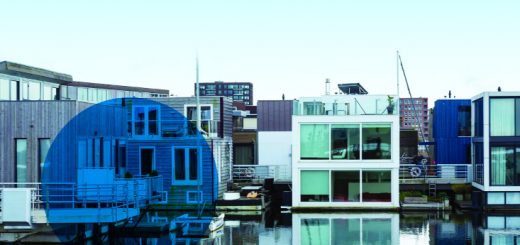Architecture Affects How You Feel
“We shape our buildings and afterwards our buildings shape us,” mused Winston Churchill in 1943 while considering the repair of the bomb-ravaged House of Commons.
More than 70 years on, he would doubtless be pleased to learn that neuroscientists and psychologists have found plenty of evidence to back him up.
We now know, for example, that buildings and cities can affect our mood and well-being, and that specialised cells in the hippocampal region of our brains are attuned to the geometry and arrangement of the spaces we inhabit.
Yet urban architects have often paid scant attention to the potential cognitive effects of their creations on a city’s inhabitants. The imperative to design something unique and individual tends to override considerations of how it might shape the behaviours of those who will live with it. That could be about to change.
“There are some really good [evidence-based] guidelines out there” on how to design user-friendly buildings, says Ruth Dalton, who studies both architecture and cognitive science at Northumbria University in Newcastle. “A lot of architects choose to ignore them. Why is that?”
Last month, the Conscious Cities Conference in London considered how cognitive scientists might make their discoveries more accessible to architects. The conference brought together architects, designers, engineers, neuroscientists and psychologists, all of whom increasingly cross paths at an academic level, but still rarely in practice.
One of the conference speakers, Alison Brooks, an architect who specialises in housing and social design, told BBC Future that psychology-based insights could change how cities are built. “If science could help the design profession justify the value of good design and craftsmanship, it would be a very powerful tool and quite possibly transform the quality of the built environment,” she says.
Greater interaction across the disciplines would, for example, reduce the chances of repeating such architectural horror stories as the 1950s Pruitt-Igoe housing complex in St Louis, Missouri, whose 33 featureless apartment blocks – designed by Minoru Yamasaki, also responsible for the World Trade Center – quickly became notorious for their crime, squalour and social dysfunction. Critics argued that the wide open spaces between the blocks of modernist high-rises discouraged a sense of community, particularly as crime rates started to rise. They were eventually demolished in 1972.
Pruitt-Igoe was not an outlier. The lack of behavioural insight behind the modernist housing projects of that era, with their sense of isolation from the wider community and ill-conceived public spaces, made many of them feel, in the words of British grime artist Tinie Tempah, who grew up in one, as if they’d been “designed for you not to succeed”.
Today, thanks to psychological studies, we have a much better idea of the kind of urban environments that people like or find stimulating. Some of these studies have attempted to measure subjects’ physiological responses in situ, using wearable devices such as bracelets that monitor skin conductance (a marker of physiological arousal), smartphone apps that ask subjects about their emotional state, and electroencephalogram (EEG) headsets that measure brain activity relating to mental states and mood.
“This adds a layer of information that is otherwise difficult to get at,” said Colin Ellard, who researches the psychological impact of design at the University of Waterloo in Canada. “When we ask people about their stress they say it’s no big deal, yet when we measure their physiology we discover that their responses are off the charts. The difficulty is that your physiological state is the one that impacts your health.” Taking a closer look at these physiological states could shed light on how city design affects our bodies.
One of Ellard’s most consistent findings is that people are strongly affected by building façades. If the façade is complex and interesting, it affects people in a positive way; negatively if it is simple and monotonous. For example, when he walked a group of subjects past the long, smoked-glass frontage of a Whole Foods store in Lower Manhattan, their arousal and mood states took a dive, according to the wristband readings and on-the-spot emotion surveys. They also quickened their pace as if to hurry out of the dead zone. They picked up considerably when they reached a stretch of restaurants and stores, where (not surprisingly) they reported feeling a lot more lively and engaged.
The writer and urban specialist Charles Montgomery, who collaborated with Ellard on his Manhattan study, has said this points to “an emerging disaster in street psychology”. In his book Happy City, he warns: “As suburban retailers begin to colonise central cities, block after block of bric-a-brac and mom-and-pop-scale buildings and shops are being replaced by blank, cold spaces that effectively bleach street edges of conviviality.”
Another oft-replicated finding is that having access to green space such as woodland or a park can offset some of the stress of city living.
Vancouver, which surveys consistently rate as one of the most popular cities to live in, has made a virtue of this, with its downtown building policies geared towards ensuring that residents have a decent view of the mountains, forest and ocean to the north and west. As well as being restorative, green space appears to improve health. A study of the population of England in 2008 found that the health effects of inequality, which tends to increase the risk of circulatory disease among those lower down the socioeconomic scale, are far less pronounced in greener areas.
How so? One theory is that the visual complexity of natural environments acts as a kind of mental balm. That would fit with Ellard’s findings in downtown Manhattan, and also with a 2013 virtual reality experiment in Iceland in which participants viewed various residential street scenes and found the ones with the most architectural variation the most mentally engaging. Another VR study, published this year, concluded that most people feel better in rooms with curved edges and rounded contours than in sharp-edged rectangular rooms – though (tellingly perhaps) the design students among the participants preferred the opposite.
The importance of urban design goes far beyond feel-good aesthetics. A number of studies have shown that growing up in a city doubles the chances of someone developing schizophrenia, and increases the risk for other mental disorders such as depression and chronic anxiety.
The main trigger appears to be what researchers call “social stress” – the lack of social bonding and cohesion in neighbourhoods. Andreas Meyer-Lindenberg at the University of Heidelberg has shown that urban living can change brain biology in some people, resulting in reduced gray matter in the right dosolateral prefrontal cortex and the perigenual anterior cingulate cortex, two areas where changes have previously been linked to early-life stressful experiences.
It sounds counterintuitive: surely the sheer number of people makes social interaction more likely. While this may be true superficially, the kind of meaningful social interactions that are crucial for mental health do not come easily in cities. Social isolation is now recognised by urban authorities as a major risk factor for many illnesses. Is it possible to design against it, to build in a way that encourages connection?
One of the first to try was the sociologist William Whyte, who advised urban planners to arrange objects and artefacts in public spaces in ways that nudged people physically closer together and made it more likely they would talk to each other, a process he called “triangulation”.
In 1975, the Project for Public Spaces, founded by one of Whyte’s colleagues, transformed the way people used the Rockefeller Center in New York City by placing benches alongside the yew trees in its basement concourse (instead of the people-repelling spikes the management had originally wanted). The architectural firm Snohetta has followed a similar principle in Times Square, introducing long sculpted granite benches to emphasise that the iconic space, once clogged with cars, is now a haven for pedestrians.
Enriching public spaces will not banish loneliness from cities, but it could help by making residents feel more engaged and comfortable with their surroundings. “Living among millions of strangers is a very unnatural state of affairs for a human being,” says Ellard. “One of the jobs of a city is to accommodate that problem. How do you build a society where people treat each other kindly in that kind of setting? That is more likely to happen when people feel good. If you feel positive you’re more likely to speak to a stranger.”
One thing that is guaranteed to make people feel negative about living in a city is a constant sense of being lost or disorientated. Some cities are easier to navigate than others – New York’s grid-like street pattern makes it relatively straightforward, whereas London, with its hotchpotch of neighbourhoods all orientated differently and the Thames meandering through the middle, is notoriously confusing. At the Conscious Cities conference, Kate Jeffery, a behavioural neuroscientist at University College London who studies navigation in rats and other animals, made the point that to feel connected to a place you need to know how things relate to each other spatially. In other words, you need a sense of direction. Places with rotational symmetry, which look the same whichever direction you look at them from – Piccadilly Circus, for example – are a “nightmare” for orientation, she said.
A sense of direction is equally important inside buildings. One of the most notoriously disorientating buildings is the Seattle Central Library, which has won multiple awards for its architecture. Northumbria University’s Dalton, who has studied the building for several years and has edited a book about it, says she finds it fascinating that a place so “universally admired by architects… can be so dysfunctional”.
One of the issues with the library is the huge one-way escalators that sweep visitors from the ground floor into the upper reaches with no obvious means of descent. “I think there was a desire by the architects to try and thwart expectations and be a bit edgy,” says Dalton.
“Unfortunately when it comes to navigation, our expectations are there for a good reason. There are very few situations in the real world where you can go from A to B via one route and you’re forced to take a different route from B back to A. That really confuses people.” On an online forum, one of the library’s users commented that she had “left the building as soon as I could figure out how to get out, hoping I wouldn’t have an anxiety attack first.’’
But that’s the thing about cities: people who live in them do a good job of making them feel like them home despite all the design and architectural obstacles that may confront them, be it in a byzantine library or a sprawling park.
A visible manifestation of this are the “desire lines” that wend their way across grassy curbs and parks marking people’s preferred paths across the city. They represent a kind of mass rebellion against the prescribed routes of architects and planners. Dalton sees them as part of a city’s “distributed consciousness” – a shared knowledge of where others have been and where they might go in the future – and imagines how it might affect our behaviour if desire lines (or “social trails” as she calls them) could be generated digitally on pavements and streets.
She is getting at a point that architects, neuroscientists and psychologists all seem to agree on: that successful design is not so much about how our buildings can shape us, as Churchill had it, but about making people feel they have some control over their environment. Or as Jeffery put it at Conscious Cities, that we’re “creatures of the place we’re in”. Welcome to the new era of neuro-architecture.
















Recent Comments